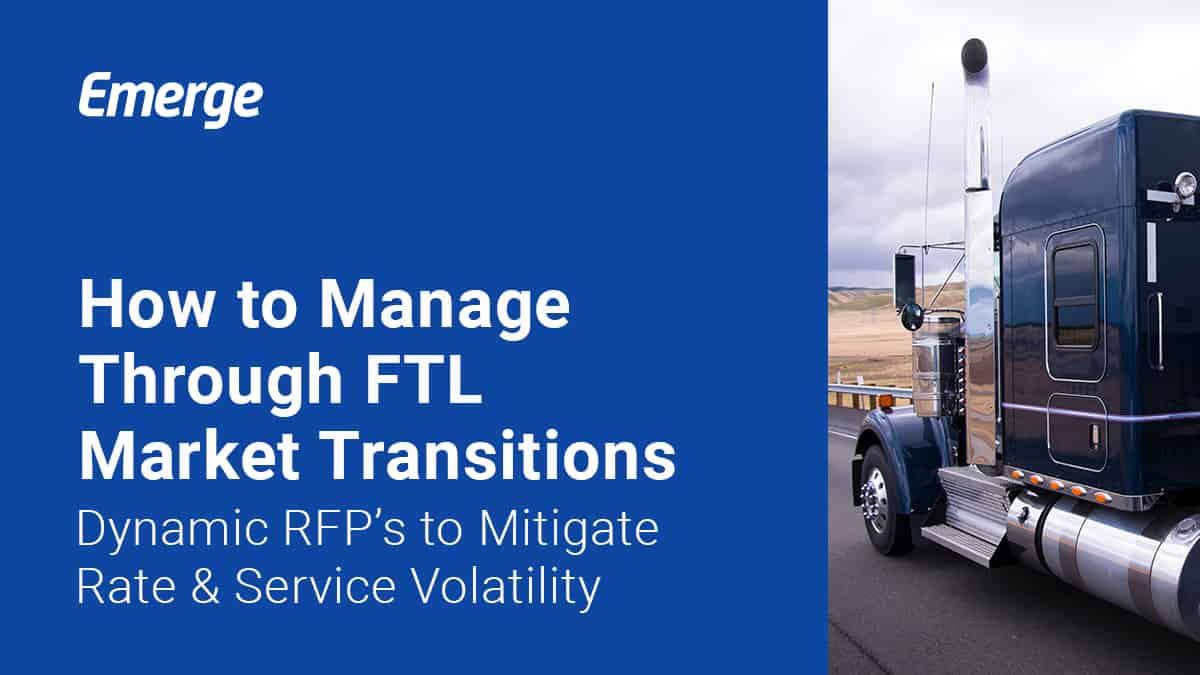Other FreightWaves Products
Sponsor
White Paper: Driver Sentiment Shift Towards Acceptance of In-Cab Video Cameras
With driver shortages dominating the news, you might be concerned to roll-out a new safety system like dashcams and video safety. However, there are many reasons that drivers accept – […]
Overcoming today’s challenges in fleet telematics
As telematics technology continues to evolve, ConMet is poised to stay on the cutting edge of intelligence and data science in the commercial vehicle industry.
Three reasons to hire entry-level CDL drivers in 2021
The driver shortage, while not a new problem, requires new approaches to resolve.
Locomation taps former USDOT Deputy Assistant Secretary of Policy as Vice President of Policy and Strategy
To drive development of regulatory policies and autonomous vehicle standards as they intersect with freight transportation, autonomous trucking technology firm hires VP Finch Fulton.
7 Steps to Strategic Partnership Between Shipper and Service Provider
Being a diversified strategic partner is essentially the holy grail of long-term partnership and relationship success.
A huge bipartisan opportunity for Congress is here, and it involves autonomous trucking
By Finch Fulton, Vice President of Policy and Strategy at Locomation and former Deputy Assistant Secretary for Policy at the US Department of Transportation Developments in autonomous trucking regulations are […]
A History of Autonomous Vehicles You May Not Know
Walt Disney predicted the technological advances of autonomous vehicles in his 1958 short film called “Magic Highway.” Read more about the history of AI-driven automobiles.
How automation helps carriers manage claims, prevent future accidents
Automation will mitigate exposure created by process errors and duplication of efforts by integrating disparate systems.
White Paper – Case Study: MeMD Helps Trucking Company Save $34,000 Annually with Virtual Care
This case study outlines how MeMD’s telehealth solution met all objectives while delivering nearly $34,000 in savings.
White Paper: How to Optimize Critical Medical Deliveries to Save More Lives
This white paper shares what happens when time-critical shipments are mismanaged or lost, and how to solve this devastating problem.
Real-time pricing vs. spot pricing: What’s the difference?
The most fundamental difference between real-time pricing and spot pricing is that one is by design and the other is by mistake.
What can shippers do now to get a more reliable container supply chain?
Reliability in container shipping depends on visibility. Cargo shippers should encourage their carriers and service providers to adopt standards that ensure consistent data and timely exception handling across carriers.
Beating the System
Although it took several years for Epay to gain traction in the market and become profitable, the general consensus among brokers who used it to manage carrier payables was, they wanted it to do more.
White Paper: The Big Book of Shipper’s Links
The shipping business is tough. We could all use a tip, trick, and new set of tools to help us out. Here’s the 115 best websites, apps & FREE online resources every shipper needs to bookmark for 2021.
White Paper: How to Protect Your People, Business and Cargo During Civil Unrest Events
The following guidelines can be used to help you prepare, adapt, mitigate and recover from potential loss.
White Paper: How to Manage Through FTL Market Transitions
Using Dynamic RFP’s to Mitigate Rate & Service Volatility
Carriers with AI-supported accounts payable processes gain competitive edge
“Ignoring ways to optimize work processes may be the death knell for some companies.”
White Paper: The 2020 Great Holiday Rewrite
Learn why 72 percent of shippers don’t feel set up for success this holiday season.
White Paper: The Future of Pharmaceutical Shipment Tracking
This paper shares recent advancements that enable the safe, transparent transport of vaccines.
Warehouses must brace for COVID-19 vaccine distribution
FDA approval is only the first step in the process.
Finding the Best Route: A Long-Term Strategy for Top Transportation Talent
Before COVID-19, demand for supply chain talent, especially truck drivers, was at an all-time high, outstripping supply and creating major worries for companies across all industries.
White Paper: The Five Steps to Resuming Transportation Operations
This white paper features a 5-step process that will help advise the transportation industry on how to prepare, plan and execute a return to workplace action strategy amid the coronavirus with guidelines and best practices.
Are small truckload carriers worth saving?
Their inability to guarantee coverage is the primary reason why small carriers have been confined to the spot market, and as a result, they’ve earned rates that are often less than half of the rates paid to larger carriers.
White Paper – 2021 General Rate Increase: A Year Like No Other
3 Mistakes You Don’t Want to Make with the GRI
E-Book: COVID and the Case for Digital Standards
Container shipping has a paper problem, and it’s never been more obvious than in 2020.
The Complete Guide to Cross-Border Freight
From customs paperwork, to carrier requirements, to potential security clearances… Absolutely everything you need to know about shipping freight between the U.S. and Canada.
White Paper: 4 Ways Supply Chain Visibility Drives Results
This new e-book from the experts at Penske Logistics explores how real-time data can help improve decision making, strengthen relationships and mitigate disruptions.
The Mystery of CPG #X: How a CPG Shipper Partnered with the Premier Provider of Logistics Technology and Services to Deliver Enhanced Performance and Cost Improvement
Transplace collaborates with shippers and carriers to optimize financial and service performance with advanced logistics management technology and services.
Improving Cash Cycle Management for the Long Haul
This white paper details how carriers can work to gain better visibility into their financial status and strengthen relationships with their customers.
How to Solve the Digital Transportation Puzzle
When focusing on the movement of goods, transportation management systems (TMS) provide the engine for digitalization, but do not represent a complete digitalization solution.
White Paper: Guide to Dedicated Contract Carriage
This guide outlines the requirements and benefits of a well-structured DCC arrangement.
White Paper: Master Guide for Calculating Freight Class
The “Master Guide for Calculating Freight Class” will help you manage your freight costs, budget and boost your bottom line.
A new sustainability program with Feeding America to reduce waste and rescue food from supply chains
In complex supply chains, not every delivery to a grocery store, wholesaler or food service provider is perfect, due to a number of factors that lead to massive waste.
How artificial intelligence is keeping time-critical shipments on track during pandemic
For specialized industries such as health care and aerospace, the stakes of supply chain interruptions and service failures have never been higher.
Evaluating the Need for Dedicated Fleets in the Era of Digitalized Transportation
Shippers may feel like they are being pulled in two different directions when it comes to dedicated fleet solutions.
A digital freight marketplace built by shippers for shippers
Savvy shippers and carriers need to be able to take advantage of new technology and information quickly and easily to ensure they are remaining competitive during these volatile times.
Niagara Selects Convoy as National Carrier of the Year for the 2nd Year in a Row
This marks the second year in a row that Convoy has won this prestigious award from Niagara.
Enabling Carbon Reduction Goals with Transparency in Scope 3 Carbon Emissions
Shippers are making carbon reduction an explicit aspect of the procurement processes for their supply chain.
7 Compliance and Safety Questions to Ask Your Freight Broker and 3PL Partners
Compliance risk is serious business for shippers, and it can have significant repercussions. Just consider cargo theft, which is merely one aspect of compliance risk.
Coronavirus (COVID-19) Resource Center
Welcome to Convoy’s Resource Center for Coronavirus (COVID-19).
6 Ways to Make Your Shipping Facilities More Carrier Friendly (And Why It Matters)
The trucking capacity crunch, driver shortage, and electronic logging device (ELD) mandate are working together to create a carrier’s market right now.
What you need to know about empty miles in trucking
Waste matters. For nearly every industry, waste contributes to higher costs. But in the freight industry, the stakes are even higher.
A New Sustainability Program to Support Supplier Diversity
CHEP’s iconic blue pallet is not just a product offered to customers—it’s also a unique source of data that helps eliminate waste across CHEP’s network of partners, which include most of the largest consumer packaged goods companies in the world.
Understanding and Evaluating Your Transportation Options
Two opposing forces are making the task of transportation management more difficult than ever.
Hubtek gathers transportation companies for 1Day Virtual Conference
The webinar series will run on April 2, 2020 from 10:00 a.m.-600 p.m. EDT, with a 10-minute introduction session at 9:45 a.m.
Accessing Analytics & Metrics to Meet On-Time In-Full Performance Goals & Customer Expectations
As supply chains speed up, fulfillment windows shrink, and customer delivery expectations evolve, the need for comprehensive supply chain metrics, KPIs, and analytics will only expand.
The continual innovation of the J.B. Hunt 360 platform keeps carriers top of mind
The recent Stay Metrics Stay Index Report echoed consistent themes among truck drivers: they want to work for companies with a driver-centric culture and get paid fairly for their time and service. Stress related to lack of home time, equipment troubles, and delays were highlighted as top concerns. While the focus of the report wasn’t specifically researching new trucking technology, integrating digital tools into everyday processes can address these concerns.
Consolidation helps shippers satisfy modern consumers’ and retailers’ demands
To remain competitive in the marketplace, shippers need to adapt.
A catalyst to change: using commercial map intelligence for business innovation
“We need to arrive on-time, every time!” “We need better visibility!” “We need more technology!”
Commentary: the demise of the freight brokerage
Larger shippers must think beyond the short-term peaks and valleys.
Location intelligence is business intelligence
Data is enabling businesses across industries to optimize their resources and become more efficient, and commercial trucking is no exception.
How brokers and 3pls process invoices
A look at how brokers and 3pls process invoices. Sponsored by HubTran.
Value is more than just a base rate
Leverage real-time analytics and data collection to save you and your customers money across categories.
Finding transportation capacity during the crunch
DHL explains why it is important for shippers to work with a 3PL for their transportation needs.
On the road again – three ways data is enabling smarter transportation management
Learn how existing and future technologies will continue the evolution of supply chains, transportation and warehousing.






























































